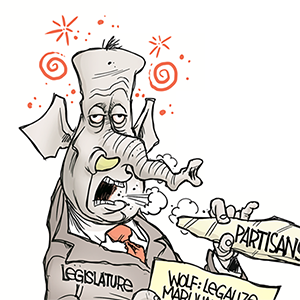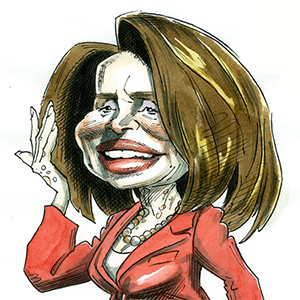Why does Colorado have so many ballot measures?
Published in Political News
Colorado voters had the chance to weigh in on 14 ballot measures when they voted in November 2024, covering a wide range of issues, including abortion, school choice, taxes, trophy hunting and primary elections.
Denver voters faced an additional 11 ballot measures.
These measures were in addition to voting for president and other federal, state and local officials.
Is this asking voters to make too many decisions? And why were there so many ballot measures in the first place?
I have studied and written about ballot measures for more than 30 years and recently published a book called “Let the People Rule,” and often get questions like those.
Colorado’s 14 measures were the most in the country this year, with Arizona a close second with 13. While this isn’t even close to a record for Colorado – there were 32 propositions on the ballot in November 1912 — the number has grown considerably over the past 60 years.
Colorado’s ballot contains two types of ballot measures: “Initiatives” are citizen-sponsored proposals, while “legislative” measures are sponsored by elected legislators.
To get an initiative on the ballot, sponsors have to collect signatures from fellow citizens equal to 5% of the number of votes cast in the previous gubernatorial election.
In 2024, half of the measures in Colorado were initiatives and half were legislative.
The state also allows “referendums,” which are votes to repeal existing laws, but they are rare.
While in all states citizens vote on certain legislative measures, such as constitutional amendments or the issuance of bonds, only 24 permit citizen-led initiatives.
I counted up the number of initiatives, or citizen-sponsored measures, for each state. Since 1960, a total of 166 initiatives have come before the voters in Colorado. This puts Colorado third among states in initiative activity, behind California with 263 and Oregon with 191, but above Washington with 139, North Dakota with 88 and Arizona with 85.
Since 1960, the Colorado Legislature has placed an additional 133 measures on the ballot. This is not an extremely high number compared with other states: Colorado ranks only 18th in terms of legislative proposals.
As described in my book, political observers have argued about the merits of citizen lawmaking – “direct democracy” – since the founding of the republic.
Elected officials and political elites generally dislike initiatives, preferring to have laws made by elected representatives instead of by the people directly. They argue that voters lack the knowledge to make good decisions; but they may also simply dislike giving up power.
Voters, on the other hand, strongly support voting on ballot propositions, favoring citizen lawmaking over representative lawmaking by about 2 to 1 in polls.
Colorado voters adopted the initiative process in 1910, and most other initiative states adopted around the same time, during the Progressive Movement. The Progressive Movement – not to be confused with the contemporary “progressive” label – was a bipartisan centrist movement that sought to professionalize government and cleanse it from what the reformers saw as capture by powerful interest groups, particularly corporations and big-city machines. Advocates for adoption of the initiative and referendum included both Republican President Theodore Roosevelt and Democratic President Woodrow Wilson.
The impulses that drove the Progressive Movement are still alive today, and have heightened recently. According to opinion polls, a sizable majority of voters no longer trust government and believe that government officials do not care about their interests. Initiatives give citizens a chance to overrule their elected representatives if they feel those representatives have lost sight of their interests.
A striking example of this recently has been initiatives in some red states that sought to replace highly restrictive abortion laws with more balanced, centrist laws that better reflect majority opinion.
If elected officials adopt policies favored by the majority, then there would be little reason for citizens to sponsor initiatives. Part of the reason, then, for so many initiatives in Colorado recently is likely that voters are not feeling well-represented by their elected representatives, at least on certain issues.
From this perspective, having a large number of ballot measures is a symptom of a problem, not the problem itself. I’d even argue that the measures are a healthy way of trying to solve the problem of poor representation.
But this only follows if you believe that voters are able to make good decisions on the measures that come before them. As I explore in detail in my book, some argue that policy issues are too complicated for ordinary people to decide, and that because of their ignorance, they are easily manipulated by big-spending interest groups.
Colorado’s Proposition 129 on the November ballot, for example, proposed to create a certification program for veterinary assistants under which they would be able to provide some services currently available only from veterinarians. The text detailing the regulations was nine pages, over 3,200 words, and not easy reading. The opposition campaign was funded by veterinary associations, who argued that the new veterinary assistants wouldn’t be adequately trained to do surgery on pets as the law allowed.
While this concern about overloading voters has some merit, I don’t believe it should be taken too far. For one thing, my examination of the history of initiatives across the country shows that corporate interests typically do less well under citizen lawmaking than when dealing with the legislature, which, incidentally, may explain why many business interests oppose the initiative process.
The other thing that’s important to understand is how voters decide on ballot measures.
While writing my book, I reviewed a great deal of research showing that voters do not, in fact, study the underlying statutory text of a ballot measure and try to parse its meaning. Instead, they read the ballot summaries and rely heavily on advice from informed parties they trust, such as family, friends, advocacy groups, politicians and journalists.
For example, on a civil liberties issue, some voters may follow the recommendations of the American Civil Liberties Union; on a tax issue, some may follow the National Taxpayers Union. Research has shown that by using these shortcuts, voters often are able to overcome the complexity and campaign ads to cast votes that accurately represent their interests.
In the case of Proposition 129, voters approved the law for veterinary assistants, even though opponents substantially outspent supporters.
This article is republished from The Conversation, a nonprofit, independent news organization bringing you facts and trustworthy analysis to help you make sense of our complex world. It was written by: John Matsusaka, University of Southern California
Read more:
Denver voters reject slaughterhouse ban, allowing Superior Farms to continue selling lamb in Colorado and nationwide
Legislative inaction and dissatisfaction with one-party control lead to more issues going directly to voters in ballot initiatives, with 60% of them in six states
10 states had abortion measures on the ballot – where they passed, where they failed, and what it all means
John Matsusaka is executive director of the Initiative and Referendum Institute at USC, a nonpartisan educational organization focused on direct democracy.




























































Comments